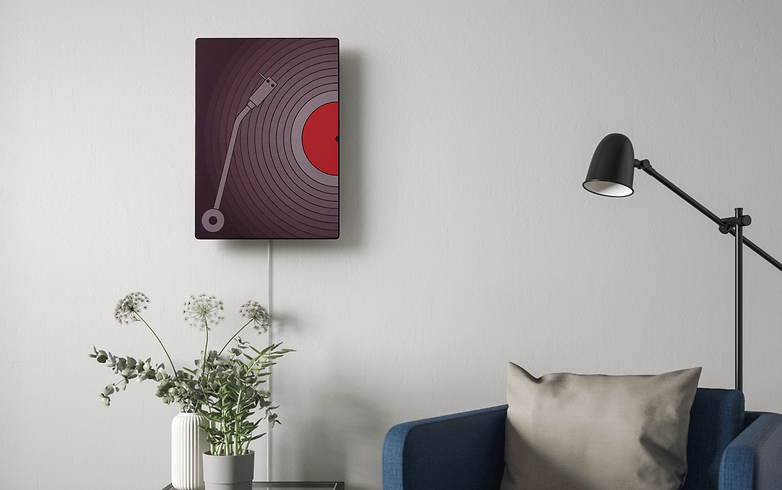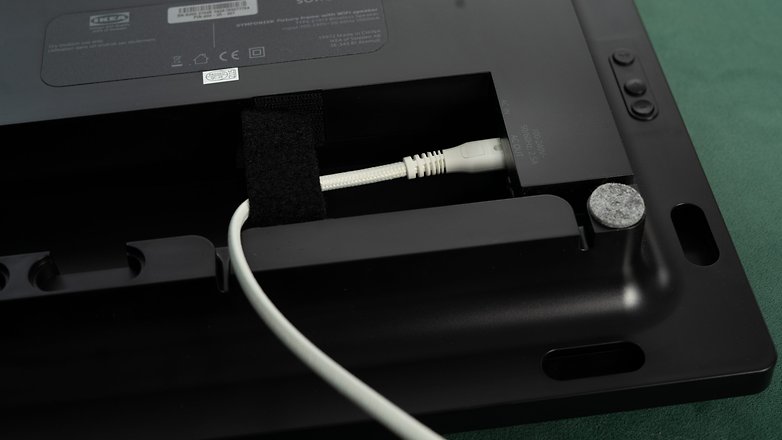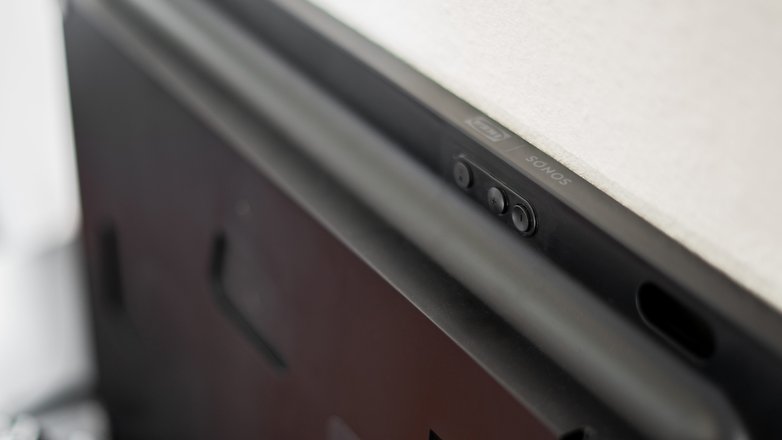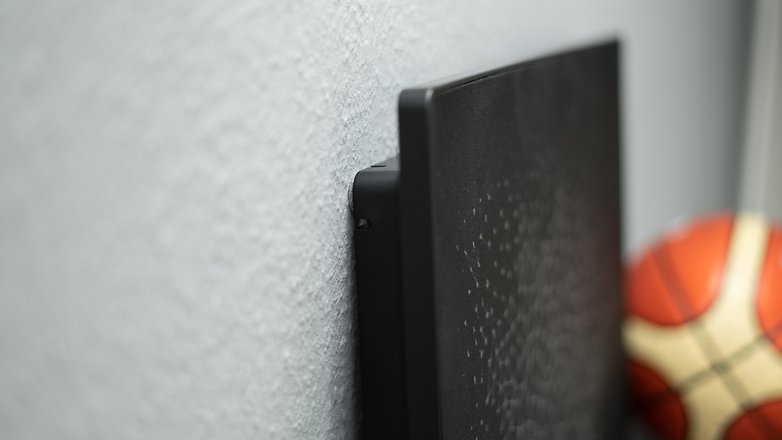
[ad_1]
Is it time for technology to take a back seat? When I was young, I had people throng my living room whenever we purchased a brand-new TV as they wanted to check it out, but fast-forward to today and it seems as though new technologies have integrated themselves so well and seamlessly that they are almost invisible within a smart home environment. But is this even meaningful and practical? Also, is this the so-called “ambient computing” that techies rave about? To find out more, NextPit decided to give the IKEA Symfonisk photo frame a closer look.
Good
- ✓Cool, simple design
- ✓Easy setup
- ✓Good connectivity to other Sonos and Symfonisk speakers
- ✓Long power cable
Bad
- ✕No Bluetooth connectivity
- ✕Needs to be plugged in all the time
- ✕No personalized printable design
Invisible technology vs. ambient computing
In this review, I will no doubt dive into the quality of the IKEA Symfonisk photo frame. How is the audio performance like, is the design good enough, and is it easy to set up? Beyond that, I would also want to reflect on the idea behind this wireless speaker photo frame.

Both IKEA and Sonos are not just trying to add technical features to conventional products with this effort. Above all, they are trying to remove technology from getting in the way of our everyday lives. Everywhere we look, there are flashing lights, ringing bells, and beeping. According to experts like Daniela Otto, this is one stress point that should be eliminated via digital detoxing.
However, is technology ready to take a step into the background?
What “Ambient Intelligence” must achieve
The direction that Sonos and IKEA have taken with this effort, and one that Carl Pei is consciously taking with his startup “Nothing”, is known as “ambient computing“. The idea behind this is to network devices in such a way that they improve our everyday lives independently without being visible. This is not a dream of the future, but is already taking place on every smartphone.
Ambient light sensors, for instance, automatically dim the display of your smartphone based on the amount of light in your surroundings. And if you so desire, your smartphone can mute itself when you get in range with your home WLAN network. Your smartphone does this so well in the background and in a discreet manner that you don’t even notice it having done so.
The smartphone will change its settings according to your current situation and preset wishes. If it is bright outside, the display should also be brighter in order to increase visibility. The vision of ambient computing sees opportunities to help make our lives easier under more and more scenarios.
Of course, all of these needs to be supported by designs that remain unobtrusive. The Nothing Ear (1), for example, are transparent and hence could literally disappear into the wearer’s ears. But how practical is it to offer such a design without the power of technology?
So how practical would things get if technology is already taking a back seat? These days, we have to actively bring it to the foreground when using it ourselves. To get to the bottom of this question, I’d first like to introduce you to the IKEA Symfonisk picture frame in more detail.
Design: How music fits into a picture frame
In case it hasn’t become clear yet: The IKEA Symfonisk picture frame combines the design of a picture frame with the functionality of a wireless speaker
. For this, IKEA and Sonos covers a plastic frame with a piece of fabric that measures 58 cm x 40 cm x 6 cm, where there are 12 different designs to choose from. Thanks to the inclusion of WLAN connectivity, only a power cable from the speaker is required to be plugged in, although there is the option for Ethernet connectivity.
What I liked:
- Balancing act between picture frame and WLAN speaker succeeds.
- Clever cable routing system.
- High-quality power cable with fabric sheathing.
What I disliked:
- Not battery-powered means it must be plugged in all the time.
- No way to personalize design.
- Button positions are not detailed.
The idea to place technology into a picture frame reminds me of Samsung. You may be familiar with the manufacturer’s “The Frame” TVs, which you can also mount it on the wall in an almost invisibly manner. But since you will have to look at the TV when you watch it, there’s a problem here: Either you’re constantly looking up or you’re hanging a picture at “sofa view height”. This is not an issue at all problem with the IKEA Symfonisk picture frame.

Since I didn’t want to drill screws into my wall for this review (drilling is advisable since the picture frame weighs six kilograms), I placed the WLAN picture frame on a shelf right above my sofa. The weight distribution allows it to be positioned without a fixed attachment, and this feature is supported by a couple of furniture gliders that IKEA has attached to the back. Alternatively, IKEA also provides the necessary dowels and screws just in case you want to mount it on the wall.
The cable routing of the beautiful, fabric-covered power cable is solved in a clever manner. With a length of 3.5 meters, it provides plenty of flexibility for hanging. You lead it at the back via a Velcro fastener, followed by discreet cable channels. This way, the back of the IKEA Symfonisk picture frame remains flush to the wall.
If you buy two IKEA Symfonisk picture frames at once, you can connect them in a daisy chain format. Of course, IKEA also offers the corresponding cable to help you get started.

If you don’t like the design in my pictures, you can breathe a sigh of relief. You can replace the clichéd Tech-YouTuber shapes with 11 other motifs, where you can also pick up the frame in white if you wish.

One major disadvantage in this design that I noticed was the cable. This is especially stark when placed on the wall, as the cable exposes the fact that this is a musical device. An integrated rechargeable battery that you only have to recharge once every few days would have been an ingenious move here. Furthermore, there is no indication of where exactly the three control buttons are located on the frame. Hence, you will have to feel along the edges with your hand if you want to adjust the volume level via the frame.
TL;DR: Design-wise, I like the IKEA Symfonisk picture frame. With a bit of skill, it literally sinks into your home and that’s exactly what it’s meant for. However, it’s a pity that you can hardly hide the power cable and that you can’t print your own motifs.
Sound and setup: Sonos controls
IKEA has brought a strong partner on board for all its Symfonisk speakers: Sonos!
The sound specialists from the USA managed to pack a 102-millimeter woofer and a 25.5-millimeter tweeter into the device. Music is then sent to the wall over a WLAN connection. Fortunately, the Symfonisk picture frame also supports Apple’s “AirPlay 2” standard.
What I liked:
- A lot of bass for a…picture frame.
- Easy to set up.
- Always on and accessible.
What I disliked:
- Quite bass-heavy.
- Only has a 2-band equalizer.
- No Bluetooth connectivity.
- Not all media content are compatible.
After unpacking and hanging up (or placing) the IKEA Symfonisk picture frame, you will have to connect it to your Wi-Fi network. To do this, the Sonos S2 app, which is available free of charge for Android and iOS, will lead you via a pictorial tutorial. Of course, there are additional benefits to be reaped here if you already have other Sonos speakers in the house as you can then include the picture frame within a group and enjoy stereo sound.

In my case, I created a new room and integrated the speaker into the living room. I could then sent my Spotify music via WLAN to the configured room and voilá! My favorite tunes are then played back. Sonos is compatible with many popular music streaming services, offering support for AirPlay 2 as well.
As usual when it comes to WLAN speakers, you always stream music specifically from one source to the device. This is a disadvantage compared to Bluetooth speakers that can be set as an external audio source for your smartphone. If a service like YouTube is incompatible with Sonos, you are unable to listen to videos or music via the picture frame. Bluetooth would have been a really handy addition when it comes to functionality.

In general, the sound characteristics of the IKEA Symfonisk picture frame turned out to be bass-heavy in the review. Music sounded almost a little too muffled, where podcasts deliver a “car radio effect” when it comes to voices as they tend to boom in a deep manner. If you’re like me and don’t like that, you can adjust the equalizer settings in the Sonos app. More specifically, there is a paltry 2-band equalizer with an additional button for “loudness” for you to play around with.
The preset sound characteristics will please many buyers though. This is especially so, since the picture frame hangs on the wall, and it is a configuration that would work well for apartments. Unfortunately, there is nothing much that you can do to get rid of the booming bass, and the limited functionality of the equalizers might not please everyone.
TL;DR: The Symfonisk picture frame delivers a surprising amount of power, which is mainly concentrated on the bass. It can be really fun with the right music! Setup is a breeze and the ability to integrate the Symfonisk Picture Frame into an existing Sonos setup is also awesome!
Everyday use: Why I keep forgetting the Symfonisk picture frame
As you would already have read between the lines, I am quite enthusiastic about IKEA’s latest speaker
. The sound is good, the supported formats are decent enough, and you can buy a Sonos speaker for only $199.99 – making it a great by itself. Still, I ran into an interesting problem with the Symfonisk Picture Frame in everyday life: I kept on forgetting that I had it installed.
And now you might understand why I digressed a little bit at the beginning concerning “ambient tech”. This is because the IKEA Symfonisk picture frame shows very well why we absolutely need smart technologies if technology is to be less noticeable yet remain useful.

When something becomes invisible or so perfectly blended into the background that we humans normally associate it with an action, that becomes a problem. For example, my dad has a rudimentary smart home and most of the light switches in his home have been stripped of their function. If I were to follow the action “I want to turn on the light” there, I will first have to think of a non-perceptible smart speaker to activate.
This is cumbersome and diametrically opposed to the goal of ambient computing. The “smart” setup in my dad’s apartment doesn’t move technology into the background, and it doesn’t make my daily life easier, either. It requires a shift in thinking and to replace the movement of flipping a switch requires a far more complex thought process.
Back in my apartment, however, whenever I want to listen to music, I will now have to remind myself that my picture frame can do that just as well. This kind of paradigm shift makes my daily life more difficult and not easier at first. Especially since, as a tech journalist and music fan, I have a surplus of audio products in the first place.

In an existing Sonos setup, it would be a different matter. Here, my desire to listen to music would be replaced by an object that clearly fulfills that action. The Symfonisk picture frame would then “smartly” follow along and I wouldn’t have to engage actively with it.
This hurdle to overcome with “ambient intelligence” is an incredibly exciting opportunity. How does a smart assistant figure out my needs while or before I have it? How will future picture frame speakers keep me from having to think of my actions, and will I miss flipping buttons and switches just to control music? After all, there’s a trend towards analogue photography and vinyl for a reason, as everything still works “so nicely manually” there. Let me also not get started about manual transmissions in cars.
For technology to remain visible in our lives, it also has to enrich our lives. This does not mean that products like the Symfonisk picture frame are bad. After all, if we like a new product, why shouldn’t we continue to get used to it after a while?
Bottom line: Is the picture frame worth picking up now?
This subjective assessment of the question of whether technology should disappear from our everyday lives, hence I would like to follow that thought with an objective conclusion. As you can read from my ratings, the IKEA Symfonisk picture frame is a recommended product despite all of my everyday philosophical objections.
Sound-wise, it’s amazing what Sonos and IKEA can get eke out of a frame that’s measures just 6 inches in height. The ability to integrate with existing Sonos or Symfonisk setups also makes the audio picture frame a discreet secret weapon for your living room to impress people. And the workmanship as well as the build quality give the product a sense of value that is surprising at a recommended retail price of $199.99.
However, as with many of my WLAN speakers, I do miss Bluetooth connectivity as it allows you to use significantly more audio sources at the end of the day. In addition, the annoying power cable could have been avoided by including an optional battery pack or by an integrated battery, but neither is available. The fact that you can’t use your own designs or motifs will also bother many users.
If you are interested in the WLAN speaker cum picture frame, you can definitely purchase one without any issues. Following that, do take note on how you use this device and whether you had to adjust yourself to its functionality, as you ponder over the idea of ambient computing by sharing your thoughts in the comments. Maybe you’re already ready for such a change, while I’m still fiddling around with switches and buttons.
[ad_2]
Source link